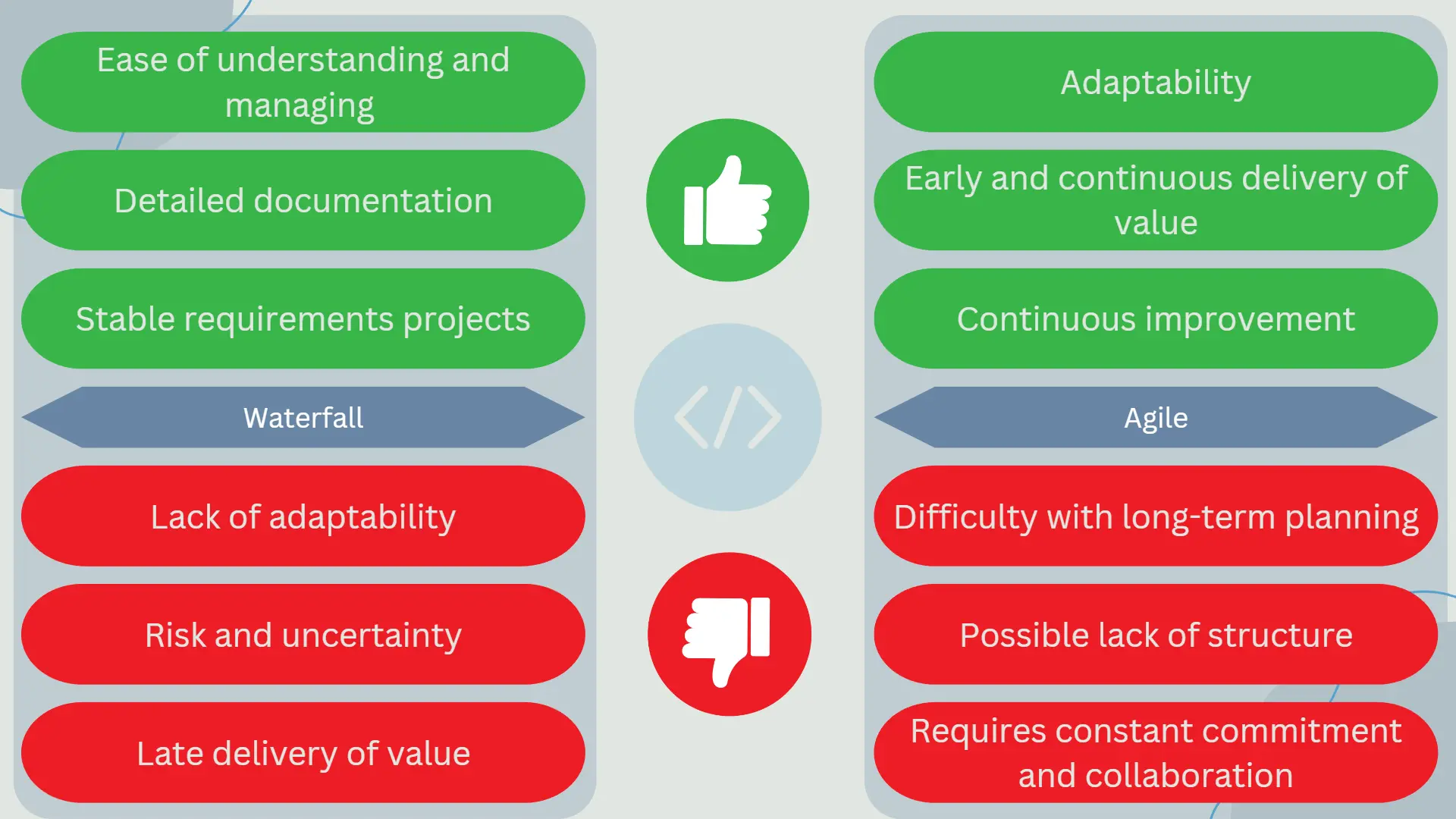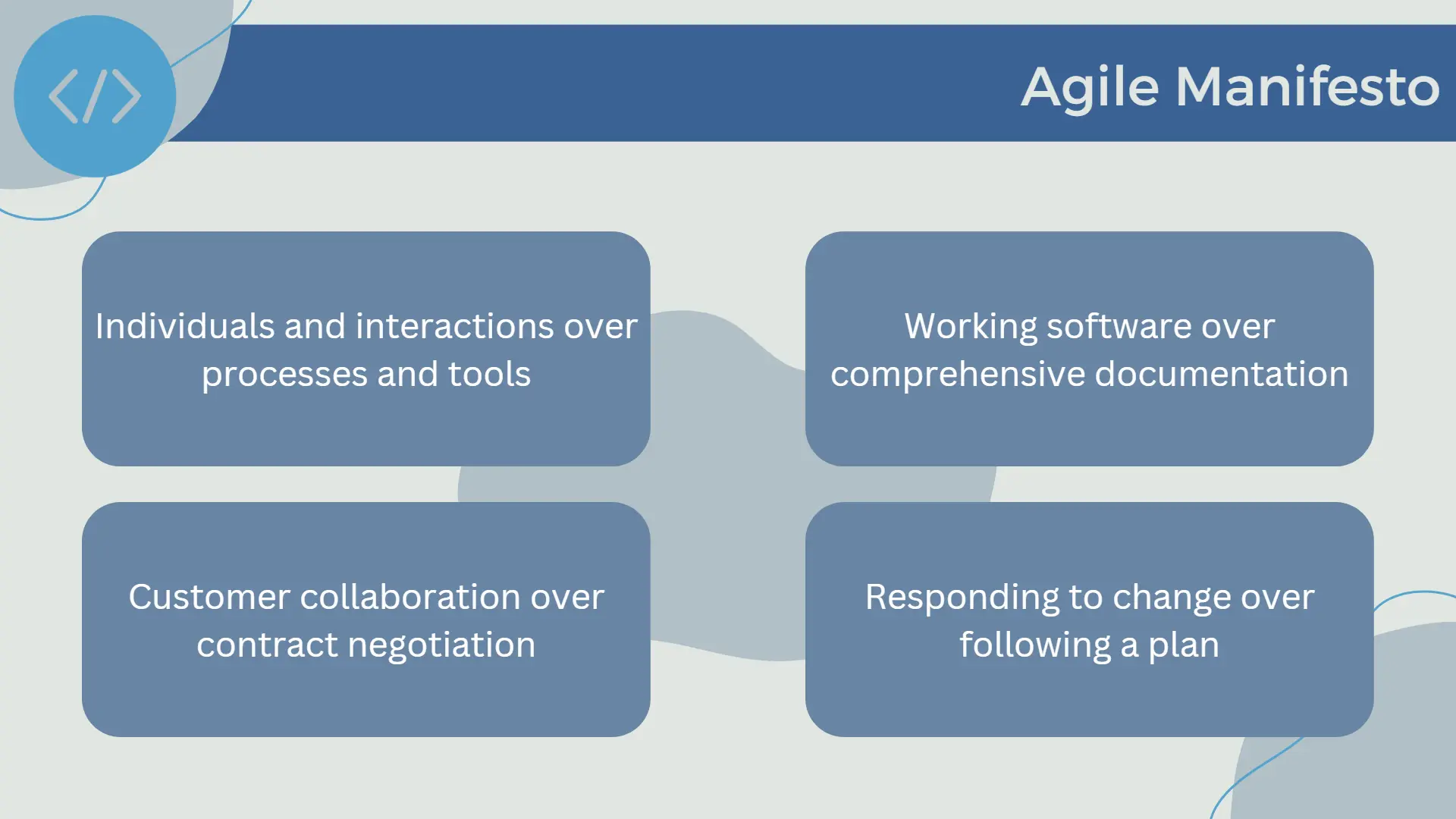Project management methodologies are structured approaches to planning, organizing, and controlling the software development process. There are different methodologies, but the most common are agile, waterfall, and hybrid.
- Waterfall Methodology: The waterfall methodology is a sequential approach where the project is divided into linear and ordered phases, such as requirements, design, implementation, testing, deployment, and maintenance. Each phase must be completed before moving on to the next. Waterfall is useful when the requirements are clear and stable from the beginning, but it has the disadvantage of being inflexible and poorly adaptable to changes.
- Advantages of the waterfall methodology:
- Ease of understanding and management: The sequential and linear approach simplifies project planning and management.
- Detailed documentation: The waterfall methodology generally involves thorough documentation at each phase of the project.
- Suitable for projects with stable requirements: It can work well in projects where the requirements are well known and are unlikely to change over time.
- Disadvantages of the waterfall methodology:
- Lack of adaptability: It does not adapt well to changes in project requirements, as changes in later phases may require redoing all the work from the beginning.
- Risk and uncertainty: Problems in the initial phases may not become apparent until the testing or deployment phases, which can result in significant costs and delays.
- Late delivery of value: End users and stakeholders do not see a functional product until the end of the project.
- Advantages of the waterfall methodology:
- Agile Project Management Methodologies: Agile methodologies are iterative and incremental approaches to software development. These approaches allow for rapid adaptation to changes and continuous value delivery to the client. Some popular agile methodologies include Scrum, Kanban, and XP (Extreme Programming). Agile teams work in short cycles called iterations or sprints, and focus on collaboration, learning, and continuous improvement.
- Advantages of agile methodologies:
- Adaptability: Agile methodologies adapt well to changes in project requirements and allow teams to respond quickly to new opportunities or challenges.
- Early and continuous delivery of value: End users and stakeholders see tangible results throughout the project, allowing for early feedback and validation of project assumptions.
- Continuous improvement: Agile teams focus on continuous improvement of their processes and the quality of their work, which can lead to greater long-term success.
- Disadvantages of agile methodologies:
- Difficulty in long-term planning: Since agile projects are iterative and adapt to changes, long-term planning can be more challenging compared to the waterfall methodology.
- Less emphasis on documentation: Some agile methodologies may focus less on detailed documentation, which could hinder communication of certain aspects of the project to other stakeholders or new team members.
- Requires constant commitment and collaboration: Agile methodologies heavily depend on collaboration among team members, end users, and stakeholders. If any of these parties are not fully committed or do not collaborate adequately, the agile process may not work effectively.
- Possible lack of structure: In some cases, if not properly implemented and managed, the agile approach can lead to a lack of structure or direction in the project, which can affect the quality of the final outcome.
- Advantages of agile methodologies:
- Hybrid Methodologies: Hybrid methodologies combine elements of agile and waterfall methodologies to adapt to the specific needs of a project. For example, a hybrid approach could start with a more structured planning and design phase, similar to waterfall, followed by agile iterations for implementation, testing, and deployment. These approaches allow to leverage the advantages of both methodologies, but they can also be more difficult to manage due to their combined nature.
The choice of project management methodology depends on the characteristics of the project, the goals, and the needs of the team and organization. It is important to understand the advantages and disadvantages of each approach and select the most suitable one for the project in question.

Waterfall Methodology
The waterfall methodology, also known as the waterfall software development lifecycle model, is one of the oldest approaches to software and system development. As mentioned earlier, it is a sequential and linear process that is divided into different phases. Each phase is completed before moving on to the next one. Typical phases in a waterfall project include:
- Requirements: During this phase, the needs and specifications of the system or software to be developed are collected and documented. Analysts work with end users and clients to understand their needs and create a requirements specification document.
- Design: The software design is divided into two stages: high-level design (system architecture) and detailed design (component and module design). In this phase, the overall architecture of the software, module interfaces, and data structures are defined. The result is a set of diagrams and documents that describe how the software will work.
- Implementation (or coding): In this stage, programmers take the detailed design and turn it into source code using the selected programming language. The software modules and components are developed and tested individually.
- Testing: Once implementation is complete, the software undergoes extensive testing to ensure that it meets requirements and functions properly. Testing may include unit, integration, system, and acceptance testing. Errors found are corrected and retested until the software is considered stable and functional.
- Deployment (or installation): In this phase, the software is installed in the end user's environment and put into operation. This may include hardware and software configuration, data migration, and user training.
- Maintenance: After deployment, the software enters the maintenance phase. During this stage, updates, bug fixes, and improvements are made as per the customer's needs.
Although the waterfall methodology is clear and easy to understand, it presents challenges when requirements are not well defined or change frequently. Additionally, due to its sequential nature, issues in one stage can delay the entire project and result in additional costs. For these reasons, more flexible methodologies like agile are preferred in many cases.
Agile Methodologies
Agile methodologies emerged as a response to the limitations of traditional methodologies such as the waterfall. The agile approach focuses on flexibility, adaptability, and fast delivery of value. The key principles of agile methodologies are summarized in the Agile Manifesto, which includes four fundamental values:
- Individuals and interactions over processes and tools.
- Working software over comprehensive documentation.
- Customer collaboration over contract negotiation.
- Responding to change over following a plan.

Given the complexity and extent of the definition of agile methods, they are detailed in the article Agile Methodologies.
